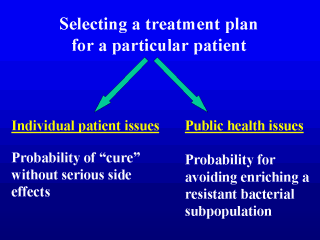 |
Two general issues arise when
selecting a treatment plan for a given patient. With respect to the individual patient,
the physician is concerned with the probability that the treatment will provide a cure
without serious side effects. The probability that resistance will arise in that patient
is generally quite low. Indeed, for most treatments it is so low that numbers are not
available (for example, with multidrug treatment of tuberculosis and directly observed
therapy, resistance has been reported to arise in only 0.01% of the cases). The public
health issues are quite different, since many patients are considered: for some diseases
millions of prescriptions are written each year. From a public health standpoint even very
rare events can be significant over the course of many patients and many years of
treatment. In the case of antibiotics, resistance is considered to be largely
irreversible. (In principle, resistant mutants could revert to wild-type cells if
resistance has a selective disadvantage in the absence of the drug; however, there is
little evidence that true reversion occurs. Instead suppressor mutations tend to be
acquired that overcome a growth disadvantage while retaining the resistance allele.) Thus,
each resistant case erodes the usefulness of an agent. Since new classes of agent are
unlikely to be available in the near future, antimicrobials must be considered
non-renewable resources. The prescribing physician is the steward of a valuable resource
and must consider both individual health issues as well as public health ones. |
